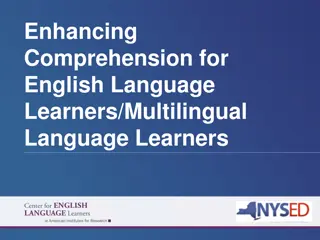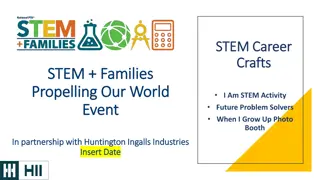Enhancing Language Learning in STEM Education for English Learners
Explore the importance of incorporating language skills in STEM education to support English learners. Gain insights on fostering multilingual skills, understanding STEM vocabulary, and promoting cultural competence in the learning environment. Enhance connections between language, science, and engineering practices for effective teaching and student engagement.
Download Presentation

Please find below an Image/Link to download the presentation.
The content on the website is provided AS IS for your information and personal use only. It may not be sold, licensed, or shared on other websites without obtaining consent from the author. Download presentation by click this link. If you encounter any issues during the download, it is possible that the publisher has removed the file from their server.
E N D
Presentation Transcript
Applying and Extending STEM Language for English Learners 2020 National ESEA Conference Vickei Hrdina, Director of Career Readiness and STEM Initiatives ESD 112, Vancouver, Washington Effie Triol, Regional Literacy Coordinator EDS 112, Vancouver, Washington
It is impossible to disassociate language from science. To call forth a concept, a word is needed. Antoine Lavoisier
Objectives Expand knowledge about language-focused STEM based learning. Explore how to support students with understanding and application of STEM content language vocabulary and language objectives. Increase understanding about the connections between the Science and Engineering Practices, NGSS, and Common Core State Standards.
Science Technology Engineering Math Making Literacy Connections with:
A persons name is to him or her the sweetest and most important sound in any language. Dale Carnegie.
What is in a name? Provides educators information about their students histories, cultures, languages, background knowledge, and experiences Assists with knowing how to effectively work with students from backgrounds unlike their own Builds respect that supports multilingual skill building as an integral part of learning Helps students feel like a welcome part of the community
Name:Eftihia Nancy Priniotakis Effie Triol Cultural Connection(s): Greek & Norwegian Named After: 1 Grandmother and 3 Cousins with name Unique Spelling: Should be spelled Eftyxia Meaning: Eftihia: Happiness Priniotakis: Tree Cutter/Hacksaw Other Information: akis designates from the island of Crete
Name: Victoria Liberty McDonnell Fisher-Hrdina Cultural Connection(s): Irish (married to a Jewish-Czech) Named After: Queen Victoria (all sisters named after English Queens) Unique Spelling: Vickei ( ei is Gaelic phoneme...we also have a Maghei and Aisloinne Meaning: Victorious, triumphant Other Information: I legally changed my middle name to Lynn in 2008 when I got married
Diamond Pattern of Interaction Lipton, Groups at Work
Names and Identity Do you know the cultural background of your name? Are you named after anyone in particular? Who named you? Does your name have a particular meaning? Does it have a unique spelling? If so, why? Is there anything else that is unique about your name that you would like to share?
NGSS: K-12 Engineering Design K-2-ETS1-1. Ask questions, make observations, and gather information about a situation people what to change to define a simple problem that can be solved through the development of a new or improved object or tool. 3-5-ETS1-1. Define a simple design problem reflecting a need or want that includes specified criteria for success and constraints on materials, time, or cost. MS-ETS1-2. Define the criteria and constraints of a design problem with sufficient precision to ensure a successful solution, taking into account relevant scientific principles and potential impacts on people and the natural environment that may limit possible solutions. HS-ETS1-1. Analyze a major global challenge to specify qualitative and quantitative criteria and constraints for solutions that account for societal needs and wants.
Common Core State Standards RI.2.1 - Ask and answer such questions as who, what, where, why and how to demonstrate understanding of key details in a text. (k-2-ETS1-1) W.2.8 Recall information from experiences or gather information from provided sources to answer a question. SL.1.1C Ask questions to clear up any confusion about the topics and texts under discussion.
Science and Engineering Practices 1. Asking Questions (Science) / Defining Problems (Engineering) 2. Developing and Using Models 3. Planning and Carrying Out Investigations 4. Analyzing and Interpreting Data 5. Using Mathematical and Computational Thinking 6. Constructing Explanations (Science) /Designing Solutions (Engineering) 7. Engaging in Argument from Evidence 8. Obtaining, Evaluating and Communicating Information
Science & Engineering Practices Focus: 1, 2 & 6 Asking Questions & Defining Problems : (1) A practice of science is to ask and refine questions that lead to descriptions and explanations of how the natural and designed world works and which can be empirically tested. Engineering questions clarify problems to determine criteria for successful solutions and identify constraints to solve problems about the designed worlds. Both scientists and engineers also ask questions to clarify ideas. Developing and Using Models: (2) A practice of both science and engineering is to use and construct models as helpful tools for representing ideas and explanations. These tools include diagrams, drawings, physical replicas, mathematical representations, analogies, and computer simulations. Designing Solutions: (6) Constructing explanations and designing solutions in 3 5 builds on K 2 experiences and progresses to the use of evidence in constructing explanations that specify variables that describe and predict phenomena and in designing multiple solutions to design problems.
Working with diverse learners is like this photograph because ________.
Synectics Model The basic tools of learning are analogies that serve as connectors between the new and the familiar good teaching traditionally makes ingenious use of analogies and metaphors to help students visualize content. (William J.J. Goodman)
Working with English Language Learners To support oral language development it is important to have a working understanding of: Language Acquisitions Stages BICS and CALP Language Objectives
5 Stages of Second Language Acquisition Preproduction Little or no experience with the English language (0-6 months) Early Production Respond with single words or phrases(6 months 1 year) Speech Emergence Uses simple phrases or sentences (1 3 Years) Intermediate Fluency Uses more complex phrases (3 5 years) Advanced Fluency Uses more standard conversation, but can still occasionally lack academic language (5 7 years) (Krashen & Terrell, 1983).
BICS = Basic Interpersonal Communication Skills The language necessary for day-to-day living, conversations with friends and family, informal interactions BICS & CALP CALP = Cognitive Academic Language Proficiency The language necessary to understand and discuss content in school (J. Cummins, 1979)
What is a language objective? Language objectives are lesson objectives that specifically outline the type of language that students will need to learn and use in order to accomplish the goals of the lesson. http://www.colorincolorado.org
Why are language objectives important? Promote student academic language growth Include the use of either receptive (listening and reading) and/or productive language skills (speaking and writing) Connect clearly with the lesson topic or lesson activities
What should a language objective include? Language objectives can be process oriented: explore, listen to, recognize, discuss, express, practice or performance oriented: define, write, paraphrase, argue, complete, read and respond. Adapted from Making Content Comprehensible for English Language Learners by Echevaria, Short and Vogt http://www.colorincolorado.org
How can Language Objectives canconnect to instructional practice? Reflective Processing How do they support language acquisition?
STEM Language Supports for English Learners STEM Language practices should be consistent with other discipline language instruction, however special attention should be made to explicitly make connections to: Vocabulary in STEM that have multiple meanings (i.e. design, analyze, process) Cultural funds of knowledge (i.e. cooking terms and procedural knowledge that relate to measurement; place names in outdoor learning) Academically Productive Talk in STEM is crucial. For support in guiding students in the 4 Language-intensive practices watch these videos Adapted from STEM Teaching Tools - Practice Brief 27 by Wingert, et al http://stemteachingtools.org/brief/27 http://www.colorincolorado.org
Three Tiers of Words Tier 3: Domain-specific words Tier 2: General academic words Tier 1: Words of everyday speech (Isabel L. Beck, Margaret G. McKeown, and Linda Kucan 2002, 2008) 2
Tier 3 words: Tier three words are domain specific and low frequency. Examples of tier three words include isotope, lathe, peninsula, and refinery. In general, a rich understanding of these words would not be of high utility for most learners. These words are probably best learned when a specific need arises, such as introducing peninsula during a geography lesson. Three Tiers of Words Tier 2 words:Words that comprise the second tier are those that are of high frequency for mature language users. These words can be multiple meaning words. They are often cross-content words. Words in the second tier may include compare, absurd, analyze, and fortunate. Tier 1 words: Not all words need instructional attention. The first tier consists of the most basic words clock, baby, happy, walk, etc. (Isabel L. Beck, Margaret G. McKeown, and Linda Kucan 2002, 2008)
Cat Safety Invention How can you stop your pet from running out the front door? Here's how Elliot from Design Squad invented a vacuum-powered, motion sensing machine to keep his cat safe! Cat Safety Invention
Focus Watch the video focusing on identifying Tier 2 Vocabulary Cat Safety Invention
With an elbow partner: Take turns sharing the Tier 2 vocabulary you identified
Focus 1) Defining Problems 2) Developing & Using Models 6) Designing Solutions Identify Elliot s actions and how they align to the three identified Science and Engineering Practices Cat Safety Invention
What connections can be made between the Science and Engineering Practices observed in the video and the identified Tier 2 vocabulary?
Design Challenge What is your Elliot inspired design? What could you design to help you in your home? Considerations What materials would be needed? How could everyday items be adapted or repurposed? What other considerations are necessary?
Did you include? Identify Practices & Standards Language Objectives Identify Problem (Challenge) Vocabulary Draft Model
Objectives Expand knowledge about language-focused STEM based learning. Explore how to support students with understanding and application of STEM content language vocabulary and language objectives. Increase understanding about the connections between the Science and Engineering Practices, NGSS, and Common Core State Standards.
Resources ASCD.org Beck, McKeown, Kucan, Bringing Words to Life colorincolorado.com Echevaria, Short and Vogt, Making Content Comprehensible for English Language Learners k12.wa.us/CurriculumInstruct/learningstandards.aspx k12.wa.us/student-success/access-opportunity-education/migrant-and-bilingual-education/funds-knowledge- and-home-visits-toolkit-overview/funds-knowledge nextgenscience.org nsta.org PBSkids.org Pixabay.com Unsplash.com
Contacts Vickei Hrdina, Director of Career Readiness and STEM Initiatives Educational Service District 112, Vancouver, Washington vickei.hrdina@esd112.org Effie Triol, Regional Literacy Coordinator Educational Service District 112, Vancouver, Washington effie.triol@esd112.org























